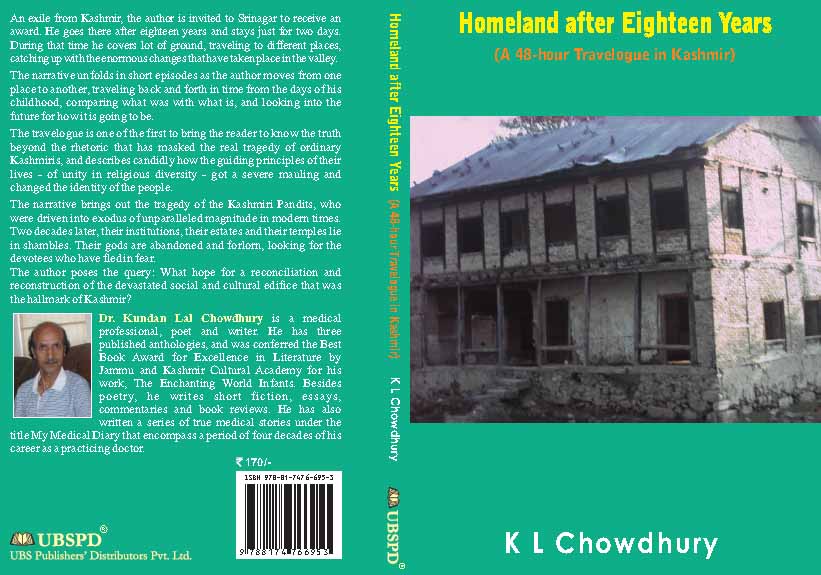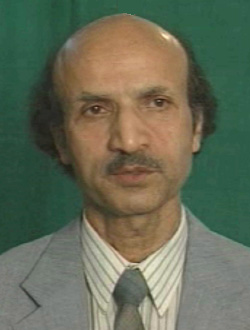Homeland
after Eighteen Years: A 48 hour Travelogue in
Kashmir
BOOK REVIEW
by Prof. K B Razdan (Phd. Ex- Prof of
English
Jammu
University)
Name
of the book: Homeland
after Eighteen Years: A 48 hour Travelogue in
Kashmir
.
Author:
K L Chowdhury
Publisher:
UBS Publishers Distributors Pvt. Ltd.
New Delhi
Year
of Publication: 2011.
Price:
Rs.170/-
Dr. K L Chowdhury’s poetic travelogue,
narrating his 48 hours stay in Srinagar and its
environs, in early October 2008, constitutes a
significant first-person singular narrative of the
author’s experiences and perceptions when he
went there to receive the ‘Lifetime Award for
the Best Book in English’ for his anthology
“Enchanting World of Infants” (2008), from the
J&K Academy of arts, Culture and
Languages.

Going
back to
Kashmir
“after eighteen years”, “nearly a
generation”, the author explains in the
“Introduction”, “was a hard decision to
make”. After “having been violently thrown
out”, as he says, going back would be “a
painful proposition”. Yet, the irresistible pull
to visit the homeland after nearly two decades,
proves eventually impossible to ignore. A
“burning desire” to go up the Shankaracharaya
hill and visit the Shiva temple at the top, along
with the magnetic tug of Rajveri Kadal in downtown
Srinagar
, his birth place “to walk the lanes, where i
spent my childhood,” become catalytic factors
which conquer Chowdhury’s initial doubts before
he decides to go and give it a try.
The
travelogue, opening with the first poem on
3 October 2008
“On Board Jet Airways, Jammu-Srinagar”,
develops into a gripping narrative in the annals
of diasporic literature. The reader finds it
virtually impossible to put down the volume, once
he or she starts to read it. Chowdhury, thanks to
his racy poetic profundity and rapidity, makes the
reader accompany him all through his journey till
his return flight on 5 October.
His deceased friend’s son, Rauf, drives
him to diverse places before the Award receiving
ceremony, and the author acknowledges that “With
young people like him, there is hope for
Kashmir
”.
Rauf’s
car becomes the contemporary Noah’s Ark, taking
the author to all those localities of Srinagar
city which remain still dear to him, churning
memories, associations, and ties, hanging like
finest silken threads in the innermost chamber of
his consciousness, and exposing the tragedy of an
ethnic minority, the Kashmiri Pandits, who were
“driven into exodus of unparalleled magnitude in
modern times”. As the narrative “unfolds in
short episodes”, when the author moves from one
place to another, the reader comes to know about
“the truth beyond the rhetoric that has marked
the real tragedy of ordinary Kashmiris”. A
climactic query is posed: “What hope for a
reconciliation and reconstruction of the
devastated social and cultural edifice that was
the hallmark of
Kashmir
?” Two decades after the outbreak of
secessionist insurgency in
Kashmir
, the author feels that though “terrorism has
beaten a retreat for some time, and threats to
life receded, yet the consolidation of an
aggressive religious mind-set and a relentless
trend to cultural and religious exclusivity”,
still pose problems and challenges.
“Homeland
after Eighteen Years” also serves as an
arresting, poetic compendium of historicism which
projects the author into the past, an investigated
past which functions as a historical agent.
Chowdhury - the doctor in real life that he is -
dissects, anatomizes, and eventually diagnoses,
the ills, afflictions and the tribulations which
have plagued and sought to tear apart the
multicultural pluralistic ethos and the
socio-cultural ambience of
Kashmir
, Mauj Kashir as
Kashmiris call it reverentially.
In
poem after poem, the verse pieces even qualify as
a hypertext, a text that builds on or contains
traces of an earlier text. Though “Homeland
After Eighteen Years” can by no means be called
as a sequel to Chowdhury’s maiden work “Of
Gods, Men and Militants” (2000), yet it does
awake in our minds as readers, the agonizing
apostatic events recorded in the author’s very
first work as an infallible specimen of diasporic
literature written in exile. To quote some lines
would be appropriate to illustrate this writer’s
point-of-view.
A
debate is sparked in the poet’s mind:
“Kashmir
has never left my thoughts /ever since I left her,
18 years back.
I
roam the lanes and by lanes/ of the home where I
was born,
the school I learnt my three Rs,/and the
hospital I worked and taught.
That was my small beautiful world/that I
would loathe exchange
even for paradise”.
How
poignant these lines become in conveying to the
reader the sheer metaphysical and psychological
agony of separation from one’s homeland and the
resultant rootlessness, anomie and angst.
Look
at these lines, unforgettable ones:
“I
often recall my friends in
Kashmir
/and remember them
beyond
their religious identities,/ and before the time
there was anything
like/ ‘them’ and ‘us’.
And
again:
“to
receive an award in person/is an honorable
proposition;
stronger
is the urge for a reunion/ with people and places
where
I spent all my childhood and prime/and my middle
years…..
where
all my forefathers lived and died,/where my soul
doth residep;
That
the award is just an excuse/thrown my way by
providence
to
fulfill my intense longing/ for a rendezvous with
the valley”.
About
the vitasta (river Jehlum), the author feels what
one can feel and say about the demonic
degeneration of the mineral world of pastoral
symbolism:p;
Alas,
what offers the sight/
is a lazy, almost stagnant stream,
duckweed
and refuse, and an occasional animal carcass
floating
on her sullied surface.
There
is no evidence, whatever,/
of her youthful voluptuous way
And
the river n deep depression/bemoaning the
valley’s transformation…
In
the quoted lines we witness the formation and
creative expression of a diasporic identity,
anchored in narrative brilliance - a form of
interpretive activity, a process of storytelling
constrained by cultural and social upheaval.
Chowdhury’s verse pieces across the pages of
“Homeland after Eighteen Years”, cumulatively,
form a narrative spectrum, an autobiographic
collage ranging from recollections of specific
events and individuals to an extended account of
virtually a lifetime experience. The connection
and the relationship between narrative and
identity, has been fruitfully explained umpteen
times. Yet, the realistic phenomenological
auspices employed by the author, vis-à-vis his
undying nostalgia and love for his lost homeland,
transform the present work as a narrative in the
form of an epistemic structure that makes reality
intelligible to us. Stories may not be lived but
only told; all the same, Chowdhury’s supple,
pliant, lucid and free-flowing lines as
travelogue, traveling back and forth in time, grip
the reader’s mind with a hypnotic tide of
emotions, recollections and attachments. Realism
combines with a distinct communitarian streak, the
author’s life in spite of enforced exile, is
narrated as a consequence of the embeddedness of
individual lives in the existence of a community:
“People
have seen through the militants,
and
the leaders who stoke their passions.
Be
it the subversives and separatists,
be
it the politicians and the ideologues,
they
all have their axe to grind;
they
give a damn for the common man
who
is dragged into this
for
no fault of his.”
Pathos
mixes with agonizing helplessness when the author
narrates that the gods and deities feel abandoned
and forgotten by their devotees who left the
valley during the enforced exodus, almost two
decades back:
“I
have no heart to go in/and seek a darshan,
for
I will have a lot to answer/to the deities
inside
that
we worshipped every day,/and a lot to hear
from them.”
These
lines refer to the famous
Ramchander
Temple
, near the
Barbarshah
Bridge
in
Srinagar
. About the Ganesha temple at the foothills of
Hariparbat fort, the lines become a virtual dirge
lamenting a lost divine glory coupled with the
absence of eager devotees and worshippers, who
would once flock to pay obeisance to the elephant
god:
“Smeared
with deep vermilion, the mound of rock here
is
naturally shaped, like the potbellied Ganeshap;
with
an elephant head and
a curled trunk,
who
has evoked such adulation down the ages.
But,
now, the rock is defaced and laid bare,
the
image tarnished beyond repair,
and
dear Ganesha, deserted by his devotees
looking
worn, forlorn and melancholy.p;
After
a visit to Pokhribal, the poet in Chowdhury
wonders:
“Who
is worse off, I wonder-
the gods here sans their flock
or the flock in exile sans their gods?”
At
Makhdoom Sahib, the author finds
“men, woman and children
praying, shedding tears, tying knots,
their faces lit up in faith.”
Yet,
he fails to understand:
“how one faith can thrive on the damnation of another;
how
can love for one nourish on hatred for the
other?”
Toward
the end of the book, when the author is back in
the Circuit House after the Award Ceremony, he
speculates about the Mindset of a top government
functionary “Who rues that good doctors and
teachers have become scarce in
Kashmir
after the Pandits ‘fled’.” The word
“fled” as a misnomer, a blatant travesty of
truth about the reason behind the enforced exodus
of Kashmiri Pandits from the valley, makes the
poet in Chowdhury register his reaction in
no-holds-barred poesy:
“I
was incensed by that word/ for it is a common
canard,
a myth perpetrated……../ that the Pandits ‘fled’
Kashmir
that they deserted their homes and hearths/for the unknown terrains of
exile”
Deliberate
disinformation and falsehood is sought to be
dispelled in these words:
“For,
it is not the common man/ but the bureaucrat
and the
manager,
the politician and the minister,/ who do not want the Pandits back”.
it is they who are the worst offenders/of our human rights
and not the common Kashmiri Muslims/who, like Rauf, would want us back”.
The climactic poem in the collection “The Return
Flight” sums up, what Leslie Fielder said about
creative, realistic technoscapes: “Cross the
border and close the gap….” On landing back at
Jammu airport, the author, himself now enriched by
the tribulation of an ‘anonymous’ identity in
what once was his homeland feels, and truly so,
that the place which has hosted him for “full
eighteen years” (Jammu) is in reality now his
home:
“How come we never owned it
as it owned us?
……..
Suddenly, I get a feeling,/
first time in these long years,
that I am returning home.
No, I am not a refugee;
this place belongs to me,
and I belong here.
A homeland for me/is a place
which gives me back my identity.”
Thus, as a postmodern ‘time-traveler’,
Chowdhury not only experiences the ironic,
paradoxical self-reflexivity in those 48 hours of
his hurricane visit to the valley, “the
paradise” turned into hell that man creates on
earth, these 48 hours, symbolically epitomize the
48 years of his life at the time of his exodus
from the place of his birth. The entire verse
pieces in “Homeland after Eighteen Years”
constitute dialogism of utterance and of the text
as utterance. Chowdhury’s 48 hours sojourn in
Kashmir
becomes a carnivalesque capsule of the first 48
Years of his earthly existence. The author was
nearly 49 when he had to bid adieu to his dear
homeland. “Homeland after Eighteen Years”,
qualifies as a work which fuses, and poetically
blends, the metaphysical and geographical terrains
of an author, who, like Albert Camus’s Sisyphus,
arrives at his own existential resolution.
|















No one has commented yet. Be the first!